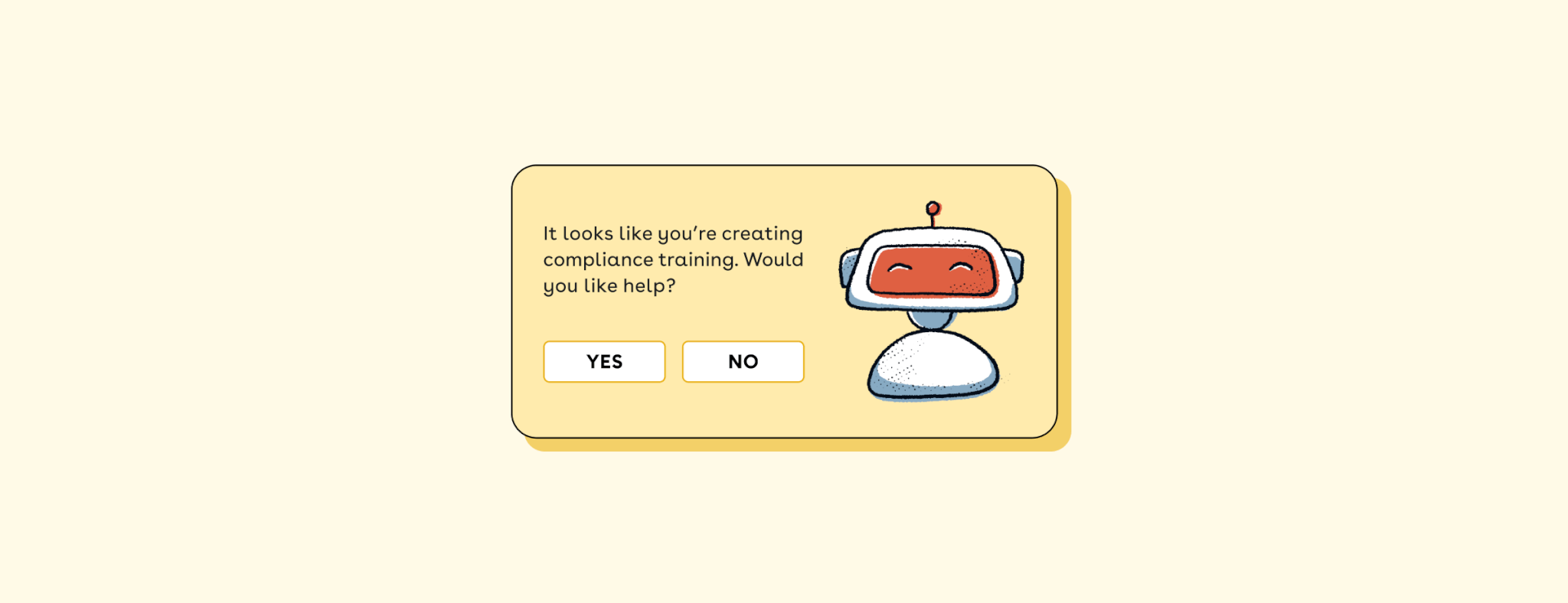Pop quiz, hotshot: What’s even better than running a clear, successful internal training that illuminates your company's workplace policies?
Answer: reinforcing those policies and testing learner retention with tailored quiz questions, of course!
The only trouble is, drafting quiz questions that actually gauge what information stuck and what didn't is an art, not a science. And while some of you reading this are likely seasoned L&D professionals with years of quizzing experience under your figurative belts, we’re betting the majority of you are first-timers.
Luckily, training is quite literally our business here at Ethena, and we’re eager to help. We started our company off of a single Harassment Prevention course, and have expanded into a compliance platform featuring double-digit trainings (you can check out our full course catalog here), a learning management system that lets you upload and assign out your own trainings, and even an employee hotline and case management tool.
Along the way, we’ve done some serious thinking about how best to test comprehension, so let’s get into where to start and how to think about drafting quiz questions on your own. (We promise it needn’t be as intimidating as it might seem!)
What do I need to know about drafting my own quiz questions for required training?
The goal here is to be able to test retention, underline best practices, and inject your own company vibes into internal trainings, but we want to start off by validating that this process isn’t easy! We have an entire content team to noodle on how to lay out information and gauge retention, so there’s no need to go it alone; we’re here to share our expertise.
So without further ado, here’s how we on the Ethena content team think through checks on learning when we’re developing a course.

Start by deciding on the purpose of your question
Ask yourself: what’s the ideal outcome for this check on learning? In our experience, you’re generally finding out and reinforcing one of two things:
- Knowledge retention — that is, does the learner know what something is?
This is the more straightforward option. Have they retained what you told them in the lesson? Do they remember a certain definition? If you’ve taught them multiple technical terms, can they identify one of them out of multiple choices?
- or application — that is, does the learner know what to do?
Application questions are where you can lay out a scenario for the learner and gauge whether or not they know how to respond. For example: “You’re in XYZ situation with ABC person; what should you do?”
Get specific about your own organization
You don’t need to replicate Ethena’s style of asking questions — we are pun enthusiasts and we strive to write for an audience whom we don’t know personally.
That’s where you have the advantage: in our experience, learners respond best to questions that are directly applicable to their day-to-day work, even ones that are quite straightforward. So there’s no need to make up a silly company name. Just use your own company — that’s even better!
In particular, a holistic application question is a great opportunity for you to get ultra-specific about your own company, using the specific terminology of your workplace. Test learners on where they should bring a specific type of concern, or what their next step is in a process according to your internal procedures.
Consider multi-tier questions
We personally love the drama of a scenario that unfolds over multiple questions, but you don’t have to be a fictioneer to take advantage of a multiple-question format. Check for knowledge retention first (i.e. what’s going on?) and then test on application (i.e. and what should you do about it?).
This way, you don’t have to build two separate hypotheticals, and you’ve made a connection between the abstract piece of information in the first question and the action required of your learner in the second question.
Make sure you’re offering strong multiple-choice options
It can be tempting to give throwaway silly options. And if your company culture abides a bit of silliness, it’s fine to add a little Easter egg among the multiple choices! But you do want your learner to really have to think.
If you’re coaching them to take a certain action, don’t make the only alternative to the right answer “Give up and do nothing” — give plausible wrong answers. Common past mistakes can inspire you here, but don’t embarrass anybody by ripping a wrong choice from the headlines of their life.
Finally, avoid true/false questions if you can, as those give you a 50% chance of guessing right without engaging with the question.
And be thoughtful about multiple-choice arrangement
Make sure the right answer isn’t always in the same position. (Anecdotally, C tends to be the popular choice on our team, so keep an eye on that.) Avoid “all of the above” as the right answer, because it’s usually basically obvious that it will be right. And wherever possible, don’t give more than five options.
Keep things short and sweet
We’ve been known to spin a tale of exquisite nuance and excruciating ambiguity now and again, but the truth is that shorter is better. Questions should be one paragraph or less — giving your learner everything they need to understand the question, and no more.
Draw on real-life scenarios when possible (and appropriate)
Like we said, don’t call out anybody’s specific past mistakes in a way that they or others can recognize, but do “write what you know” — i.e. base your scenarios on real things that have happened at a workplace past or present. The easiest way to make a situation realistic is to make it real.
Consider the setting and context
Think holistically about how you’re using this training as part of your larger L&D or compliance program. Maybe you want to start with an easy question in an introductory training, and throw them a harder one later on down the line. Or, do you want to use the training as a level-set before a live session? You might create a question that’s particularly thorny or a scenario with a lot of gray area, and use it as a jumping-off point for a live discussion. Training is a piece of a greater learning journey you’re leading for your team, so tailor your questions accordingly.

It’s time to get quizzing with Ethena’s new quiz question authorship feature
A great quiz question puts your learner’s final burst of attention on what you most need them to retain, allows them to get the hang of what they need to do in a true-to-life situation, and — when they get it right — lets them wrap up their training with a sense of knowledgeability and accomplishment. So here’s one for you.
Q: How can you empower yourself to teach best practices and company policies, as well as test your team’s knowledge with scenarios they’ll recognize?
A: Talk to an Ethena team member about LMS Essentials today.









